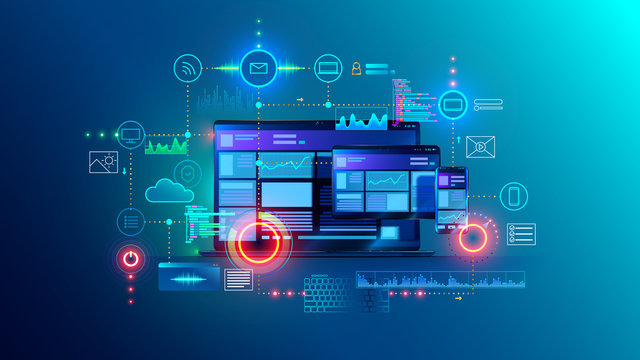Progressive web design refers to websites that are responsive, work offline, and provide an app-like experience. These sites adapt to any screen size while providing interactive features that don’t require downloading an app. Progressive web apps load quickly even with a poor internet connection. They take advantage of features like push notifications to engage users.
Innovative web design incorporates creative and unique elements to produce cutting-edge websites. This type of web design goes beyond templates to craft something original. Animation, 3D elements, and unconventional layouts help innovative sites make an impact. These websites also utilize the latest web development trends and features.
Together, progressive and innovative approaches create the next generation of web design. This is critical for businesses who want to impress customers and keep up with competitors. Investing in a progressive, innovative website demonstrates a commitment to offering users the best possible experience. The result is higher customer satisfaction, engagement, and conversions.

Characteristics of Progressive Web Design
Progressive web design focuses on providing an optimal user experience and accessibility across all devices and platforms. Unlike traditional web design, progressive web apps utilize the latest web capabilities to create fast, reliable, and engaging user experiences. Here are some key characteristics of progressive web design:
Mobile-First, Responsive Design
Progressive web apps are built using a mobile-first approach, with fluid responsive design to optimize the viewing experience on any screen size. Flexible layouts, relative units like REM, and responsive media queries allow the design and content to adapt seamlessly across mobile, tablet, and desktop. This ensures web apps look great and function flawlessly regardless of the device.
Focus on User Experience and Accessibility
Progressive web apps aim to create intuitive, frictionless user experiences. Interactions are designed based on how users expect web apps to work. There is a strong focus on speed, with techniques like skeleton screens and asynchronous data-loading to avoid jarring transitions or blank screens. Accessibility is also a priority, utilizing semantic HTML, alt text, color contrast, and other techniques to support those with disabilities.
Progressive Enhancement
Progressive enhancement means the core content and functionality is accessible on any browser or device, then enhanced progressively with advanced features for capable browsers. The base experience is accessible to all, while allowing more immersive experiences on modern browsers and platforms. Technologies like service workers, web push notifications, geolocation, and others provide these progressive enhancements.
In summary, progressive web design focuses on the user first and foremost. By leveraging the latest web capabilities, these sites provide fast, reliable access on any device while creating intuitive experiences that feel like native mobile or desktop apps.
Unique Web Design Services
Progressive web design agencies offer unique services to help brands stand out as for example https://theqream.com/services/brand-strategy. Some of the most innovative offerings include:
Animations and Parallax Scrolling
Animations and parallax scrolling add visual interest and help guide users through the site. Subtle animations when hovering over buttons or scrolling can make interactions more dynamic. Parallax scrolling creates an immersive effect as different content layers scroll at different speeds. This captures attention and makes content areas pop.
Interactive Elements and Microinteractions
Interactive elements add functionality and flair. Some examples are drag-and-drop interfaces, sliders, hover effects, and swipe or scroll actions. Microinteractions are small design details that delight users through feedback and rewards. These could be notification popups, animated icons, or sound effects. They enhance engagement during each user interaction.
Augmented Reality Integration

Augmented reality integrates digital elements into the real environment. Web design agencies can incorporate AR into sites and apps. Users can point devices at physical objects to trigger 3D models, videos, or other AR experiences. This technology fosters innovation and provides an extra layer of engagement.
Progressive agencies offer expertise in these specialties. Their creative application of new technologies produces unique, memorable sites and apps. Brands can leverage these services to provide delightful experiences that set them apart. The interactive elements capture attention, enhance branding, and encourage users to return.
Web Design Trends
The world of web design is constantly evolving with new trends emerging each year. Some of the hottest trends right now include:
Brutalist Web Design
Brutalist web design is characterized by raw, blocky layouts and elements according to Lumify Learn. It typically utilizes very basic HTML and CSS without many graphics or visual flourishes. The harsh, bare-bones aesthetic is a reaction against over-designed sites and embraces the rawness of early web design. Brutalist sites load fast and focus on content over appearance. This no-frills style works well for sites that feature text-heavy content.
Minimalism
Minimalist web design embraces white space, clean lines, and simplicity. Websites feature plenty of breathing room and avoid clutter. The focus is on drawing attention to the most important elements and creating intuitive navigation. Typography and color palettes tend to be muted and understated. Minimalism creates sites that are stylish yet straightforward. This timeless aesthetic works across desktop and mobile platforms.

Vivid Color Schemes
Many modern sites employ bold, saturated hues and eye-catching color schemes. Vibrant colors add energy and make key elements pop. Gradients are also popular, blending vibrant colors into color transitions. Vivid colors create sites that are playful, energetic and memorable. When balanced well, vivid hues make for fun and engaging designs.
These current trends allow designers to create progressive sites that are stylish, usable, and tailored to brand identities. Sites blend influences from these trends to craft experiences that appeal to modern users. As web design continues to evolve, new trends will emerge while some mainstays persist. Paying attention to trends helps create sites that feel current.
Conclusion
In this article, we discovered that progressive and innovative web design is more important than ever for businesses looking to stand out online. With website visitors expecting a smooth, fast, and aesthetically-pleasing experience, companies need web design that not only looks good but also leverages the latest technology.

